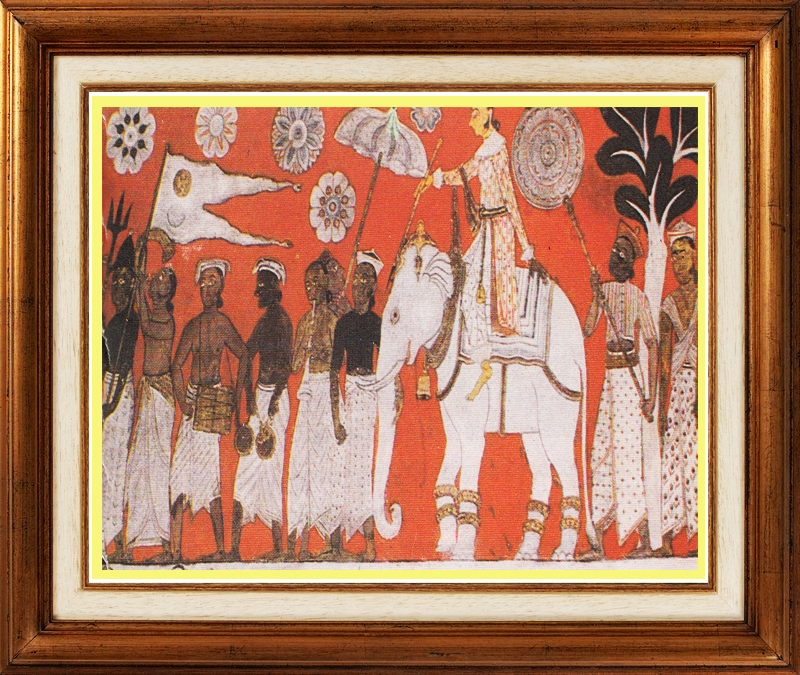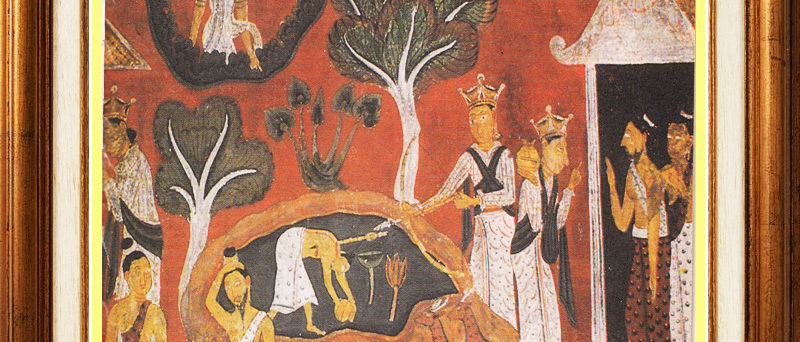The old paintings were done when the temple was rebuilt in the Kandyan period. They decorated the walls and ceilings of the two chambers of the old wing. In these old paintings we could clearly notice South Indian influence on Sinhala art. There are also traces of Western influence in respect of social life and dress.
The Viharage or the image house now consists of two shrine rooms, the old and the new, in one building under two roofs. The appearance of the temple from a distance is very impressive. On coming closer we are struck by the marvellous artistic ability of those who built it.

The Viharage is 150 feet long and 90 feet broad. It stands on a stone plinth 3 feet in height. Over the new shrine room is an octagonal roof thatched in the Kandyan style of roofing.
Around the outer walls, there are three ornamental freezes that run right round from one end to the other. The first freeze, at the bottom is a row of elephants with mahouts and carved trappings. The second freeze is a row of merry little dwarfs, displaying their antics. The third freeze is a row of geese, popularly known as the sacred geese.
Above these freezes and on each side of the walls outside are what are called, the Vimanas or the mansions of gods. There are nine of these recesses or alcoves. These Vimanas are a new feature at Kelaniya. The only other place we find them in Sri Lanka is Polonnaruwa.
Turning left, when you walk round clockwise, the first you come across is that of Ganesha the Hindu god of wisdom, and the patron god of learning. He is represented by a figure half-man and half-elephant, in sitting posture with a large belly and a head of an elephant.
The next Vimana is that of Ganga Devi, or river goddess, the daughter of Himavat, the king of mountains. Her figure with “elongated eyes, bulbous breasts, willowy waist and lissom limbs” is sure to fascinate and enchant anyone who sets eys on her. Next comes the Vimana of Vishnu, the Hindu god honoured by the Buddhist of Sri Lanka as their patron god. The next Vimana houses Vibhishana, the patron deity of Kelaniya. He is here shown being crowned as King of Lanka by Rama. The figure, sitting beside him is his queen Amman. The next three Vimanas, in order, are those of Maitri Bodhisatva, Manikkhika, the Naga king of Kelaniya and Skandakumara the god of Kataragama.

The eighth Vimana depicts the Buddha setting his footprint on the summit of Samantakuta or Adam’s Peak at the invitation of Sumana the patron deity of Sabaragamuwa. In the ninth Vimana, we see god Saman himself with his face turned towards Sri Padasthana, the spot where the sacred footprint is, of which he is the guardian deity.
Having made the round, we now come to the main entrance of the Vihara. Here there is a flight of stone steps leading to the verandah. It is flanked on either side by Gajasinghas, or the elephant headed lion of solid stone. After the verandah is found the main doorway leading to the Vihara. On either side of this, in imposing style, are two figures. They are the doratupalas or the guardians of the door.
The doors, windows and the pillars are all of Kandyan design and style. As you enter into the middle chamber or vestibule you could see against the right wall the colossal statue in bold relief of Maniakkhika, the Naga king flanked by two rampant lions in relief. Painted on the walls on either side are two naga kanyas or damsels. Flanking the doorway leading to the right inner chamber, the sanctum, are doratupalayas or janitors, in relief.
The paintings in these two chambers belong to the Kandyan period. The other walls of this middle chamber are mostly painted with Jataka stories, giving the name of each story below each strip of panels. On the left wall are also displayed the Mara Yuddha, the Buddha’s battle with the forces of mara and also the solosmasthana or the sixteen sacred shrines.
On the ceiling looking sky-like are depicted the planetary gods or the navagrahayo and the twelve zodiacal signs or the rashis. The front wall shows the Buddha seated, surrounded by the retinue of Arahants, on the day he visited Kelaniya.
Below, at one end are the portraits, in silhouette, of the first three incumbents of the – present Kelani Vihara succession. On the further wall are portrayed the two kings, Yathalatissa and Kelanitissa. High up above are pictures showing the Buddha spending the ‘Sat Sathiya’ or the seven weeks immediately after enlightenment.

Passing into the inner chamber, the sanctum, you see, on the right the reclining figure of the Buddha, 18 cubits long. At his head are seen two other images of the sedant Buddha or ‘otpilimas’. The suvisi vivaranaya or the twenty four approbations accorded to the Bodhisatva are depicted high up above. The wall opposite bears, at one end, the coloured pictures of Hanuman, Ganadevi and Maheswara, and at the other end Saman and Vibhissana. In between the doorways are the Sataravaram Deviyo or the four guardian gods of the four cardinal quarters of the world.
Beyond the feet of recumbent Buddha statue, screened off by curtains stand the colossal statues of the deities Natha, Saman and Skandhakumara.
